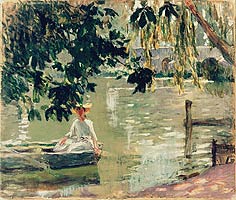Stepping stones into space
The right wing of our ‘River Scene’
consists of a 'landing stage'
that together with the trunk of the willow hinder our eyes here.
The cut
trunk of a tree or a pole are
playing an
important part in the oeuvre of
Claude
Monet. Look at the most
famous paintings: ‘Les
Grandes Decorations’,
Musée de l’Orangerie, Paris.
Watch the sun
glitter in the water and the oar preventing our eyes from slipping
out over the left edge of the painting. The focus of the eye remains
on Suzanne in full harmony. Perhaps the last correction, done to
receive this impression, is the centre part of the willow leaves,
which was painted over with a large
chestnut leaf.

The River Scene
The middle
ground is built up by the water surface, with reflections and
glittering, mirroring the blue sky. This way of painting the water
surface also creates a depth perspective. John House writes: “…with
only the ripples to act as visual stepping stones into space.”
(‘Nature into art’ chapter 3, p.53 ).
Multicoloured,
warm, horizontal brushstrokes keep the composition together. Look at
the background, with the bridge with the vaults, and the bushes in
front, reflected on the open sheet of water.
House
again: “ Monet’s problem was to find a way, whilst preserving this
spatial differentiation, of weaving foreground and background
together into a single pictorial effect.” (‘Nature into art’ p.72).
See also how
the bright sun light effect is intensified by the creamy strokes on
top of the bridge in the ‘River Scene’! Together with the similar
strokes in front they strengthen the composition. We find the same
technique in the painting: ‘Effet
d´automne à Argenteuil’, 1873, (W 290).
The author of the book ‘The way the great
masters paint’ writes: ”The horizontal, light blue brushstrokes
create a single, linear indication in the motif, and keeps the
composition together. The creamy brushstrokes in the buildings
create a feeling of heat and vibrating sunshine. In its extreme
simplification, it is remarkably realistic.”

Effet d´automne à Argenteuil

Click
Here for a comparison together with River Scene

Click
HERE for detail. |
Furthermore
this is also the painting, about which House wrote: ”with only the
ripples to act as visual stepping stones into space.”
The bridge with the arches we recognise from e.g. ‘Bridge
at the Moulin de Limetz’ (W.1210).
Doing a quick survey over
motifs painted by Claude Monet, we will find that the arch
is one of the most dominating architectural elements used by the
artist. We find it in bridges like here. In the facades of the
Cathedrals, and the series of the Charing Cross & Waterloo Bridges,
The Villas in Bordighera, The Palazzi, and, of course, the Japanese
Footbridge in Giverny, among others.
The Artist’s passion for the
arch is obvious. For Monet it is of course
a grateful motif, with it’s immanent possibilities. Mysterious,
symbolic, architectural, and adapted to create a natural depth
perspective - already in our minds.
Press HERE for next
page
|